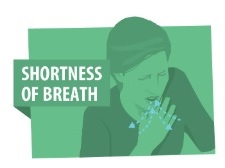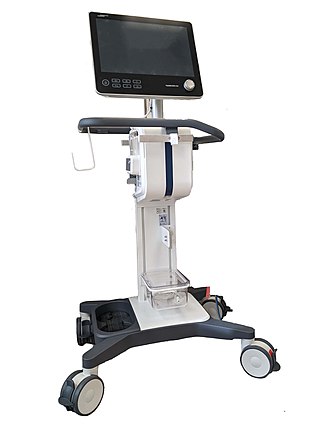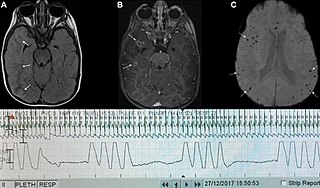Presentations

Presentations of labored respiration include:
Labored respiration or labored breathing is an abnormal respiration characterized by evidence of increased effort to breathe, including the use of accessory muscles of respiration, stridor, grunting, or nasal flaring. [1]
Labored breathing is distinguished from shortness of breath or dyspnea, which is the sensation of respiratory distress rather than a physical presentation.
Still, many [2] simply define dyspnea as difficulty in breathing without further specification, which may confuse it with e.g. labored breathing or tachypnea (rapid breathing). [3] Labored breathing has occasionally been included in the definition of dyspnea as well. [4] However, in the standard definition, these related signs may be present at the same time, but do not necessarily have to be. For instance, in respiratory arrest by a primary failure in respiratory muscles the patient, if conscious, may experience dyspnea, yet without having any labored breathing or tachypnea. The other way around, labored breathing or tachypnea can voluntarily be performed even when there is no dyspnea.

Presentations of labored respiration include:
Causes of labored breathing include:

Shortness of breath (SOB), also medically known as dyspnea or dyspnoea, is an uncomfortable feeling of not being able to breathe well enough. The American Thoracic Society defines it as "a subjective experience of breathing discomfort that consists of qualitatively distinct sensations that vary in intensity", and recommends evaluating dyspnea by assessing the intensity of its distinct sensations, the degree of distress and discomfort involved, and its burden or impact on the patient's activities of daily living. Distinct sensations include effort/work to breathe, chest tightness or pain, and "air hunger". The tripod position is often assumed to be a sign.
Tachypnea, also spelt tachypnoea, is a respiratory rate greater than normal, resulting in abnormally rapid and shallow breathing.

A ventilator is a type of breathing apparatus, a class of medical technology that provides mechanical ventilation by moving breathable air into and out of the lungs, to deliver breaths to a patient who is physically unable to breathe, or breathing insufficiently. Ventilators may be computerized microprocessor-controlled machines, but patients can also be ventilated with a simple, hand-operated bag valve mask. Ventilators are chiefly used in intensive-care medicine, home care, and emergency medicine and in anesthesiology.

The thoracic diaphragm, or simply the diaphragm, is a sheet of internal skeletal muscle in humans and other mammals that extends across the bottom of the thoracic cavity. The diaphragm is the most important muscle of respiration, and separates the thoracic cavity, containing the heart and lungs, from the abdominal cavity: as the diaphragm contracts, the volume of the thoracic cavity increases, creating a negative pressure there, which draws air into the lungs. Its high oxygen consumption is noted by the many mitochondria and capillaries present; more than in any other skeletal muscle.
Orthopnea or orthopnoea is shortness of breath (dyspnea) that occurs when lying flat, causing the person to have to sleep propped up in bed or sitting in a chair. It is commonly seen as a late manifestation of heart failure, resulting from fluid redistribution into the central circulation, causing an increase in pulmonary capillary pressure and causing difficulty in breathing. It is also seen in cases of abdominal obesity or pulmonary disease. Orthopnea is the opposite of platypnea, shortness of breath that worsens when sitting or standing upright.
In the mammalian respiratory system, eupnea is normal, good, healthy and unlabored breathing, sometimes known as quiet breathing or a resting respiratory rate. In eupnea, expiration employs only the elastic recoil of the lungs.

Cheyne–Stokes respiration is an abnormal pattern of breathing characterized by progressively deeper, and sometimes faster, breathing followed by a gradual decrease that results in a temporary stop in breathing called an apnea. The pattern repeats, with each cycle usually taking 30 seconds to 2 minutes. It is an oscillation of ventilation between apnea and hyperpnea with a crescendo-diminuendo pattern, and is associated with changing serum partial pressures of oxygen and carbon dioxide.

Kussmaul breathing is a deep and labored breathing pattern often associated with severe metabolic acidosis, particularly diabetic ketoacidosis (DKA) but also kidney failure. It is a form of hyperventilation, which is any breathing pattern that reduces carbon dioxide in the blood due to increased rate or depth of respiration.

Biot's breathing or ataxic breathing, is an abnormal pattern of breathing characterized by variable tidal volume, random apneas, and no regularity. It is named for Camille Biot, who characterized it in 1876.

Exercise intolerance is a condition of inability or decreased ability to perform physical exercise at the normally expected level or duration for people of that age, size, sex, and muscle mass. It also includes experiences of unusually severe post-exercise pain, fatigue, nausea, vomiting or other negative effects. Exercise intolerance is not a disease or syndrome in and of itself, but can result from various disorders.
Hyperpnea, or hyperpnoea, is increased volume of air taken during breathing. It can occur with or without an increase in respiration rate. It is characterized by deep breathing. It may be physiologic—as when required by oxygen to meet metabolic demand of body tissues —or it may be pathologic, as when sepsis is severe or during pulmonary edema. Hyperpnea is further characterized by the required use of muscle contraction during both inspiration and expiration. Thus, hyperpnea is intense active breathing as opposed to the passive process of normal expiration.
The respiratory rate is the rate at which breathing occurs; it is set and controlled by the respiratory center of the brain. A person's respiratory rate is usually measured in breaths per minute.

A respiratory examination, or lung examination, is performed as part of a physical examination, in response to respiratory symptoms such as shortness of breath, cough, or chest pain, and is often carried out with a cardiac examination.
Hypopnea is overly shallow breathing or an abnormally low respiratory rate. Hypopnea is defined by some to be less severe than apnea, while other researchers have discovered hypopnea to have a "similar if not indistinguishable impact" on the negative outcomes of sleep breathing disorders. In sleep clinics, obstructive sleep apnea syndrome or obstructive sleep apnea–hypopnea syndrome is normally diagnosed based on the frequent presence of apneas and/or hypopneas rather than differentiating between the two phenomena. Hypopnea is typically defined by a decreased amount of air movement into the lungs and can cause oxygen levels in the blood to drop. It commonly is due to partial obstruction of the upper airway.
Restrictive lung diseases are a category of extrapulmonary, pleural, or parenchymal respiratory diseases that restrict lung expansion, resulting in a decreased lung volume, an increased work of breathing, and inadequate ventilation and/or oxygenation. Pulmonary function test demonstrates a decrease in the forced vital capacity.
Paroxysmal nocturnal dyspnea or paroxysmal nocturnal dyspnoea (PND) is an attack of severe shortness of breath and coughing that generally occurs at night. It usually awakens the person from sleep, and may be quite frightening. PND, as well as simple orthopnea, may be relieved by sitting upright at the side of the bed with legs dangling, as symptoms typically occur when the person is recumbent, or lying down.

Breathing is the process of moving air into and from the lungs to facilitate gas exchange with the internal environment, mostly to flush out carbon dioxide and bring in oxygen.
Central sleep apnea (CSA) or central sleep apnea syndrome (CSAS) is a sleep-related disorder in which the effort to breathe is diminished or absent, typically for 10 to 30 seconds either intermittently or in cycles, and is usually associated with a reduction in blood oxygen saturation. CSA is usually due to an instability in the body's feedback mechanisms that control respiration. Central sleep apnea can also be an indicator of Arnold–Chiari malformation.
The Pediatric Assessment Triangle or PAT is a tool used in emergency medicine to form a general impression of a pediatric patient. In emergency medicine, a general impression is formed the first time the medical professional views the patient, usually within seconds. The PAT is a method of quickly determining the acuity of the child, identifying the type of pathophysiology, e.g., respiratory distress, respiratory failure, or shock and establishing urgency for treatment. The PAT also drives initial resuscitation and stabilization efforts based on the assessment findings.